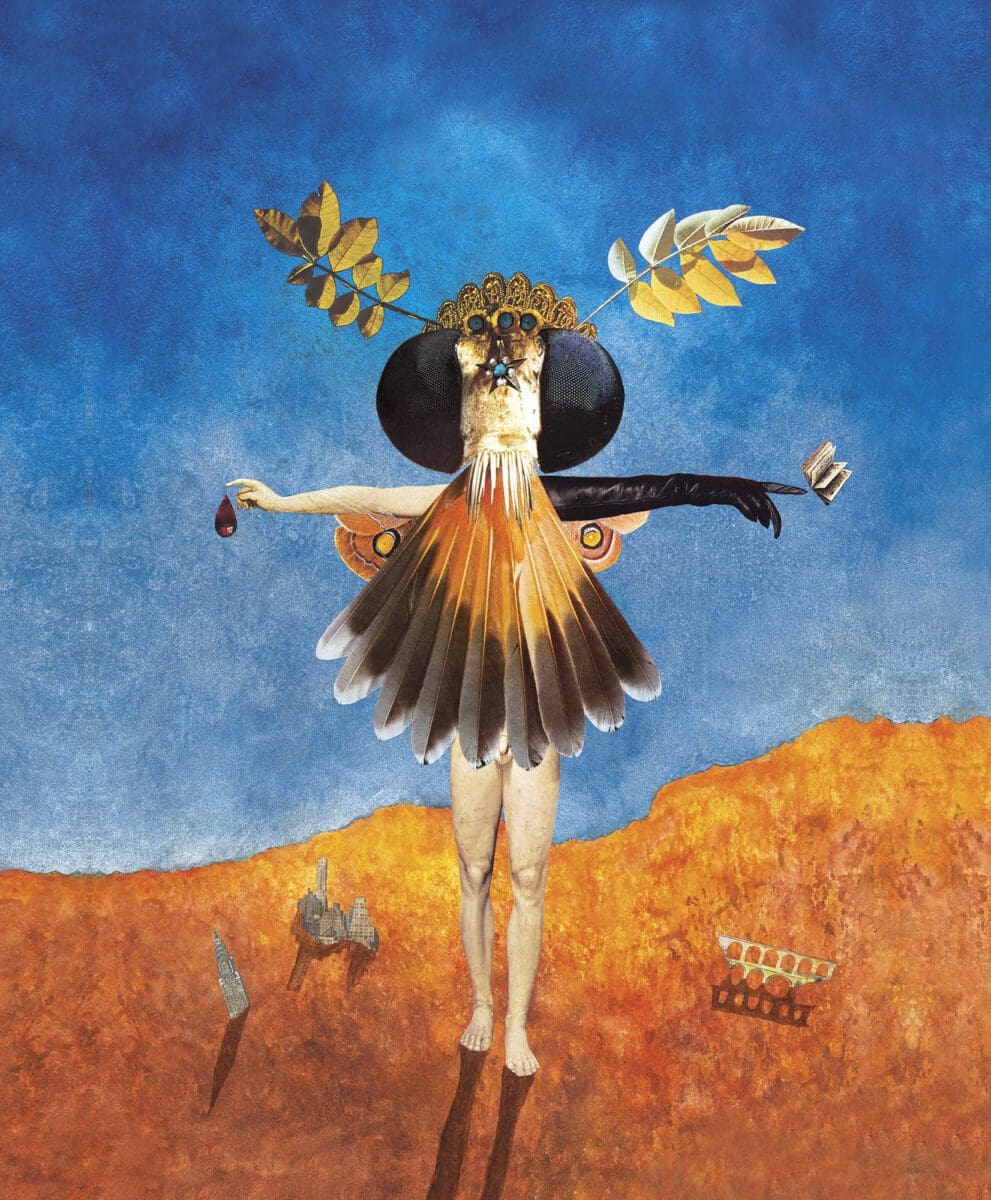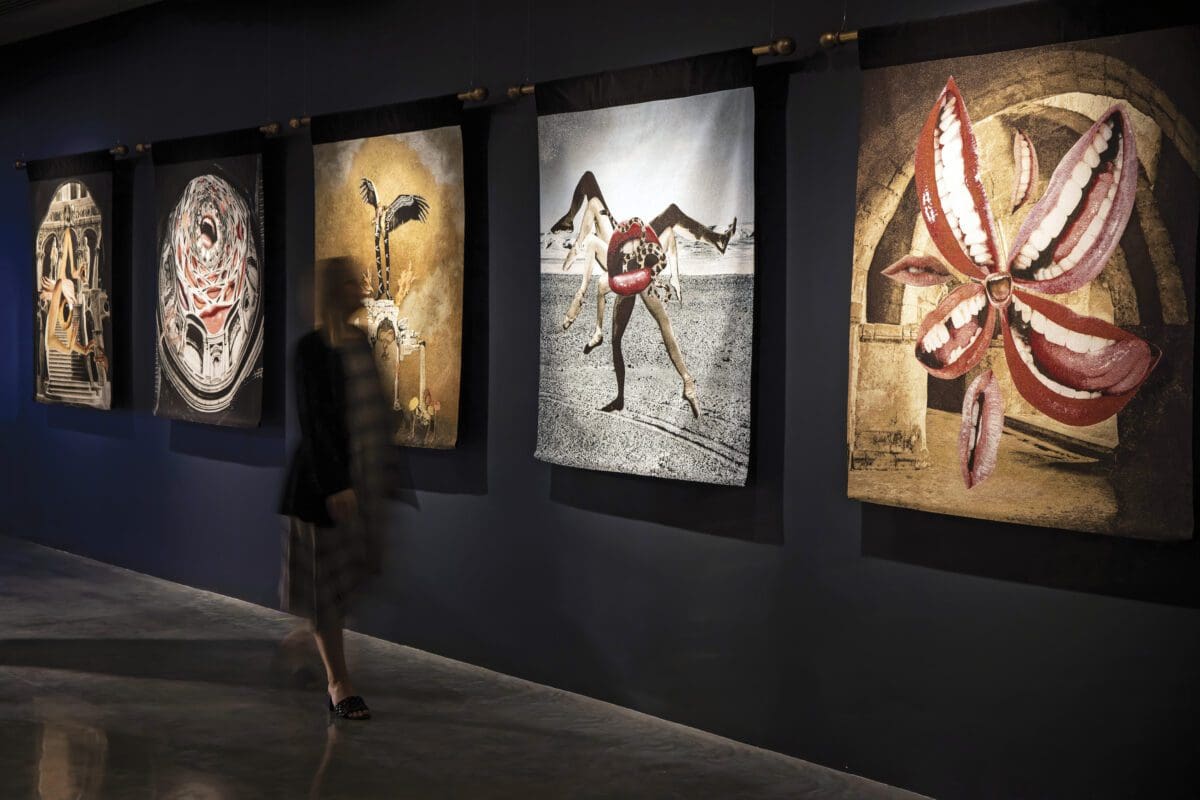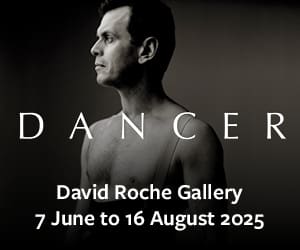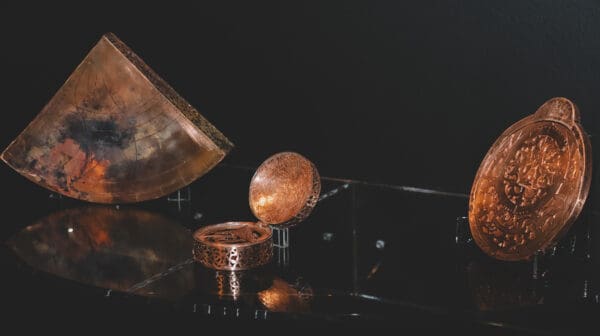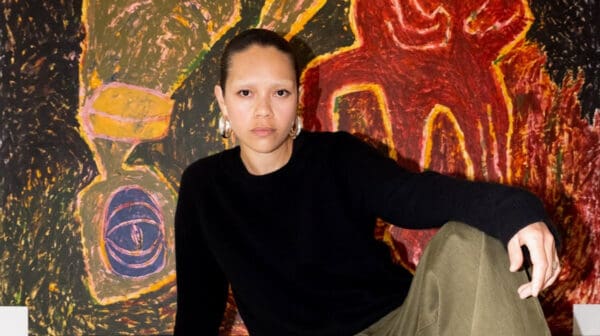The fierce momentum of Deborah Kelly is unstoppable. Beginning her creative career as a political cartoonist, Kelly’s internationally recognised practice spans 40 years and includes major commissions for the 19th Biennale of Sydney in 2014 and ACMI in 2021. As a voice for human and climate rights, Kelly’s artwork allures audiences in colourful, sexy, brash ways that engage and provoke. Kelly turns the idea of the single hero artist on its head, and instead invites a collaborative approach to art making, resulting in multi-disciplinary works involving choreographers, poets, musicians and other artists.
Her CREATION project—the establishment of a queer, science fiction, climate change religion—is incrementally gaining traction across the country as it accumulates involvement from others. Kelly has engaged with communities in Adelaide, Sydney, Newcastle, Lismore and Brisbane, creating a project that invites audiences to dance, sing, listen and perform, together, guided by CREATION leaders who have joined Kelly on a journey that has no definitive end, and will continue to morph and grow (if Kelly has her wish) for decades to come.
Kelly talks to curator Ineke Dane about her intensely collaborative and “leading by doing” modus operandi, why she wanted to start a new religion, and where it will go in the future.
Ineke Dane: Considering the performative nature of CREATION, do you have a background in performance, dance or theatre?
Deborah Kelly: Not really, though I love those art forms and my partner is involved [in them]. I did make a dance work in 2009, Tank Man Tango: a Tiananmen Memorial, and that experience has certainly contributed to making CREATION.
ID: Have you studied any disciplines aside from art that have influenced your practice?
DK: Though I didn’t complete undergraduate study, I did do a Masters of Fine Art at UNSW Art + Design a few years ago and later won a Scientia Scholarship to do a PhD on the project that turned out to be CREATION. A long, long time ago, I briefly studied law and linguistics and although I dropped out, both those fields continue to influence my thinking.
ID: Did you have a religious upbringing or childhood?
DK: Yes, I spent 13 years in a Catholic convent school. My mother was a Catholic convert and so was quite zealous.
ID: What was it within you that decided to start a new religion with a queer, sci-fi, climate change basis? Why a religion and not another form of organisation?
DK: It struck me that part of the tangled crises we’re paralysed by is the splintering of belief systems. We see it manifesting in the reality-breaking phenomena of disinformation wars conducted by armies of invisible robots on behalf of oligarchs and oil barons, Trump’s election, and the contagious rise of anti-science protestors during the ongoing global health crisis. Founding a religion was the only way I could imagine to collectively process these terrifyingly high stakes.
But also, religious practice is the origin of every art form. I very much wanted to expand from my own field into realms strange and wonderful to me. [Things] like sacred music, collective singing, choir-building, dance, ritual, legislation, ceremony, scent, food precepts, poetry, the magic of theatre, a holy book, ritual gestures, and costumes and customs. [I’m envisioning an] ecstatic, transcendent gathering.
ID: Could you talk about the strong aesthetic for CREATION—bright, mythical, allegorical, kaleidoscopic? What underpins this visual language?
DK: I wanted the aesthetic to arise from the Liturgy of the Saprophyte, the text I commissioned from contemporary artist and writer SJ Norman to form the new sacred literature at the heart of the CREATION religion. It also emerges through the distinct voices of the artists I’ve collaborated with. The development of the movements with Angela Goh and Seet Dance, alongside Alia Ardon’s cinematic eye, Lex Lindsay’s musical direction, and Melody Pei Li’s work on the animations. Plus Stereogamous, and of course the poets, singers and people who participate in the workshops. I planned to mute my own sensibility, but I guess my previous work must inform the overall project because all those words—bright, mythical, allegorical, kaleidoscopic—fill me with delight!
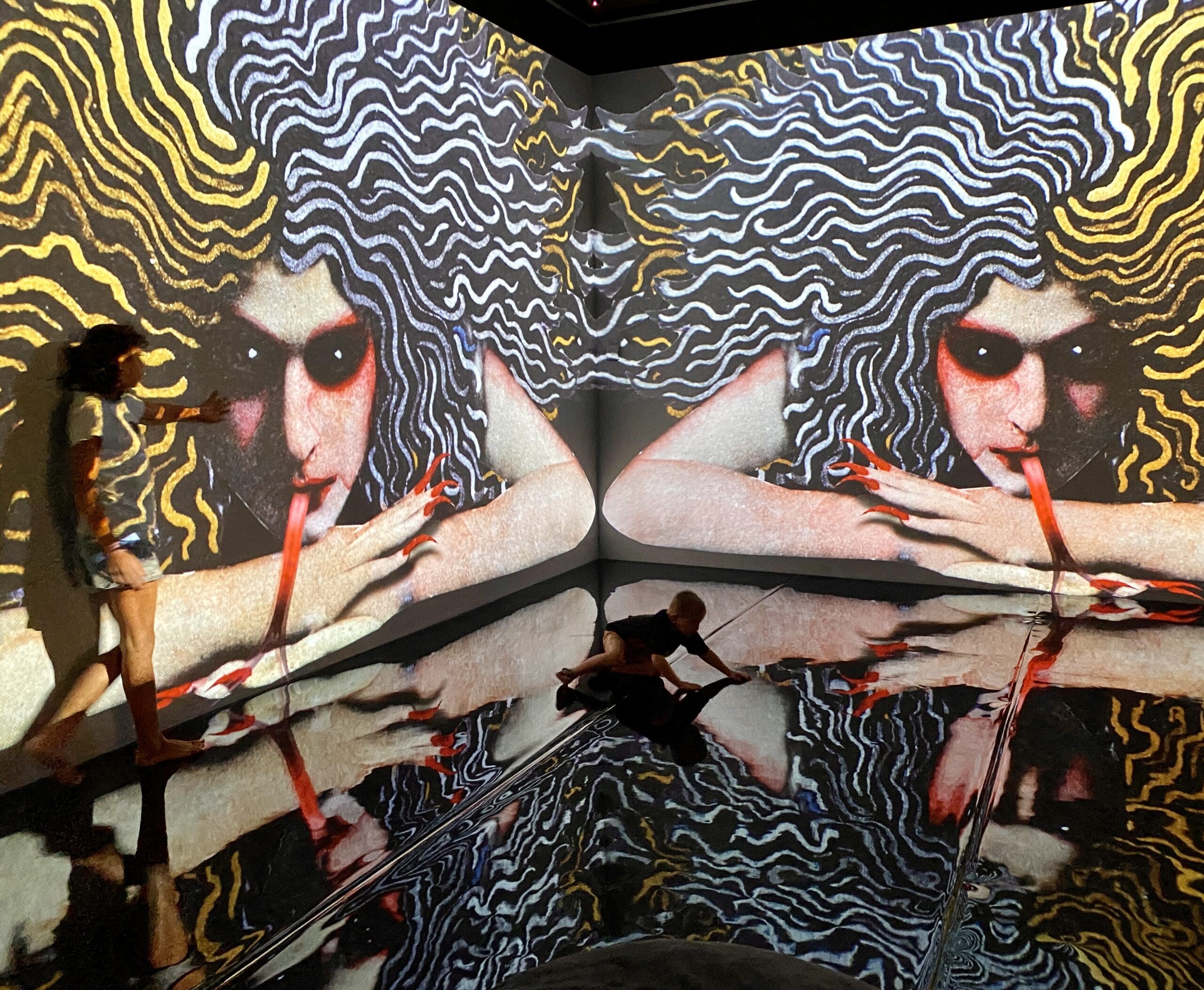
ID: You’ve said in past interviews that your idea to create a new religion came about in the Trump years when realising how willing people are to believe all kinds of absurd conspiracies. In that way is there a light-hearted parody and creative playfulness in CREATION, or should it be taken more seriously?
DK: Both answers are correct.
ID: The headdresses of the CREATION regalia are directly inspired by and linked to SJ Norman’s Liturgy—can you expand on the meaning or specific character of some?
DK: The regalia represents the Holy Orders identified in the Liturgy (The Serpent, The Rat, Fungus, Bacteria, The Spider, The Vulture) with the addition of The Moon—because much of the development [of the religion] has happened around specific moon phases—and Infinity, honouring the eight chapters of the Liturgy. The Holy Orders are emblematic of various powers and virtues, like solidarity among the scorned, survival through storytelling, clarity of sight, acceptance of death, humility, and patience.
ID: You live in a beautiful part of the world, the New South Wales South Coast, that was devastatingly impacted by the 2019/2020 bushfires. Did those fires play a part in accelerating your ‘call to act’ or to pay attention to climate change? In what way did that catastrophic environmental event galvanise you?
DK: The fires, and the then-government’s refusal to link them with the catastrophe of global warming, certainly sharpened my resolve.
ID: You describe the CREATION project as a “queer, insurrectionary, science fiction, climate change religion”—how do you see queerness and climate change as related? By using ‘science fiction’ in this description, are you worried some audiences will understand climate change as fiction?
DK: Science fiction is summoned as an act of imagining our way out of this impasse, where the heat death of the planet seems inevitable. Queerness is an invitation to defy everything expected of us; the lifeways of colonising that threaten the future, family structures and stifling gender orthodoxies that serve capitalist patriarchy. Some people do understand climate change as fiction, as they have been taught that keeping fossil fuels is viable.
ID: I’m interested also in the use of ‘insurrection’ in the description of CREATION—do you see or think that for tangible, palpable change and shifts to occur, violence is required?
DK: Colonial and eco-cidal violence against people and the planet is being committed incrementally every day and everywhere. That said, the call to ‘insurrection’ is to resist this linked, ubiquitous violence.
ID: Should one take part in the performativity of CREATION, to be included in the new religion? Or are there other ways people can practice CREATION?
DK: God, that is an excellent question. The pathways are just now opening up, I guess.
ID: I imagine you’ve had to be very ‘covid nimble’ given the global situation over the past couple of years. Has CREATION had to change to meet the challenges of worldwide pandemic and local climate catastrophe?
DK: Yes, over and over! So many plans have died tortuous deaths and later been resurrected in unrecognisable form. In Lismore I planned to work with a local artist-chef-gardener to devise the religion’s food rituals, but that became hard, then impossible. Instead the gallery facilitated the production of a series of formal portraits of local luminaries wearing the regalia; the eight vestments with headdresses. The images, shot by local photographer Mia Forrest, still represent the only time the costumes have ever been worn. They now form a significant part of the religion’s ‘treasures’ and are exhibited alongside the suspended regalia. It’s worth noting that the whole exhibition left Lismore only 10 days or so before the whole gallery was engulfed by floodwaters.
ID: What would you say to our new prime minister, if you could have lunch with him?
DK: Stop Adani! Right now! Close the Carmichael mining project and cancel all fracking licences today.
ID: Is CREATION a critique on other religions?
DK: It is a new religion, jostling for believers alongside all other belief systems.
ID: What do the proceeds of the CREATION ‘CHURCH MERCH’ go towards?
DK: Producing the book, so far. But if it passes that goal, toward further iterations of the overall work. Or maybe Rolls Royces.
ID: Why the name CREATION? Is it intentionally linked to creation theory?
DK: I wanted a huge and beautiful word. I struggled for years to find one, actually. Then there it was, shining in the air, perfect and resplendent. The fact that the word has also been used by superstitious ‘fanatics’ isn’t a problem.
ID: You’ve worked extensively with choreographer and performer Angela Goh throughout the CREATION project, can you describe this collaboration, how you met, and what you’ve learnt from each other?
DK: We met because I am her fan! We started talking about science fiction. I don’t know that she has learnt anything from me, but I have certainly learnt that Angela Goh is an outright genius. A very kind genius, and brilliant teacher.
ID: You’ve created collages as part of the works for CREATION. Are the books used to make the collages interpreting the Liturgy specific and purposefully chosen, or can the material and images come from any book?
DK: I collect books that are—in the broadest sense—the scaffolding for the self-belief of the civilisation of the old-world order. It is from their destruction that these speculations are born.
ID: The Saprophyte is an important element of CREATION. Can you explain what a Saprophyte is, and how the human species may learn from the way they exist?
DK: Saprophytes process decaying matter, bringing its energy back into the cycle for other beings to take up and pass on. It is an infinite energy exchange loop, the base dynamic of life itself.
ID: You have worked with a vast number of collaborators across disciplines, who all bring a wealth of energy and creativity to your projects and performances—do all of these collaborators have an ongoing role or pledge to practice any core beliefs of CREATION in the everyday? Or is that taking the idea of CREATION too literally?
DK: I ask people to collaborate who are already on this wavelength. Not necessarily as a religious practice though!
ID: How do you find the participants and collaborators for projects and performances? Are they people you already know? A call-out? Can anyone participate or are you looking for particular qualities?
DK: Some collaborators I have asked because I just like them and would like to hang out with them. Some people have nominated themselves—and their friends—and they turn out absolutely sterling.
ID: As you’ve toured CREATION across the country you’ve undertaken workshops with communities which culminate in the voice of a given public featuring in their local iteration of the project—do you have an archive of the stories you’ve collected in this process?
DK: I am accumulating an overwhelming array of material by this process. I wish I had an archivist to be honest.
ID: What draws you to collage as the predominant form or tool in your practice?
DK: I’d say it was a foundational tool rather than a predominant one. It’s foundational because it is free to practice, as well as small and intimate, humble and absorbing. It’s a thinking practice. If I were asked about what is predominant, I think I’d have to say the much less quantifiable substance of human exchange. Maybe even collectivity itself.
ID: How do people typically react when you tell them about CREATION for the first time?
DK: Once they parse all the adjectives, they pretty well all say, “I’m in.”
ID: The materials of your Regalia for CREATION are an alluring cacophony of cotton, wool, silk, lace, linen, mother of pearl, glass, wire, papier-mache, felt, rope, beads and pearls—are these recycled or second hand? Is sustainability an important part of your practice?
DK: The Liturgy of the Saprophyte teaches us to embrace that which can rot. So, ensuring maximum biodegradability is a religious practice here! Everything is second hand, as far as possible, which is partly about embracing the cacophony of heterogenous histories as well as an aesthetic and faithful choice.
ID: Is it your hope that CREATION one day has as many followers as other religions—Hindu, Islam, Christianity, Buddhism, Catholicism? Will there be temples?
DK: A forest is already a cathedral. So, yes.
ID: Do you feel like your practice has been leading to this culmination, to CREATION?
DK: Absolutely. It’s like I’ve been preparing this work for decades.
ID: Where do you see CREATION in 10, 20, 30 years?
DK: It depends on how history unfolds, and who we become in its unfolding. Will governments be able to evade capture by fossil fuel corporations and murderous oligarchs? That sounds so like fictional dystopia from my childhood, while turning out to just be the news. I hope that CREATION becomes one of the thousands of paths our species takes to express grief and fury at the wasted world, to organise our struggles and find pleasure in them.
CREATION is a nationally touring project heading to regional Victoria and New South Wales throughout 2023 and 2024.
Bathurst Regional Art Gallery
24 February – 21 April 2024
The corresponding monograph, The Book of Creation, published by Griffith University Art Museum in 2022, can be found here.


